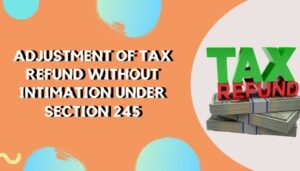 Section 245 of the Income Tax Act enables the assessing officer (AO) to adjust the refund (or a part of the refund) against any tax demand that is outstanding from the taxpayer.
Section 245 of the Income Tax Act enables the assessing officer (AO) to adjust the refund (or a part of the refund) against any tax demand that is outstanding from the taxpayer.
To help avoid litigation, the Income Tax department has trimmed the timeframe required for tax officers to decide on adjustment of refunds against outstanding tax dues to now 21 days from the earlier 30 days. According to the Directorate of Income Tax (Systems) notice, if the assessee either does not agree or partially agrees to adjustment, then the matter will be referred by CPC immediately to the assessing officer who then will provide feedback as to whether the adjustment should be made or not within 21 days from the date of the reference.
This move will allow speedy resolution of the outstanding tax dues. Further, it will minimise the time period taken by the CPC from holding the refunds beyond their allotted period.
It needs to be noted that the tax department may find some outstanding tax demands against a taxpayer’s Permanent Account Number (PAN).
Section 245 of the Income Tax Act enables the assessing officer (AO) to adjust the refund (or a part of the refund) against any tax demand that is outstanding from the taxpayer.
Further, the taxpayer will be allowed to submit a response on the outstanding tax dues notice, if he or she agrees or disagrees. Taxpayers can pay their outstanding tax demand through the e-Filing portal, however, they also have the right to disagree regarding the dues. If a taxpayer does respond to the notice, then the demand will be confirmed and will be adjusted against your refund (if any) or shown as a demand payable against your PAN ( in case, no refund is due).
A taxpayer can check if there is any outstanding demand through the e-Filing portal.
According to the income tax department website, to check pending outstanding demand — a taxpayer will need to log in to the e-Filing portal and click Pending Actions > Response to Outstanding Demand and then will be taken to the Response to outstanding demand page.
If there are demands outstanding against your PAN, the current status against each of the past/existing outstanding demands will be updated as Pending payment/Response. Accordingly, one can click Pay Now/Submit Response. Additionally, the taxpayer will receive a message on your email ID and mobile number registered on the e-Filing portal.
A taxpayer can choose to disagree by selecting an option from the list of reasons for which you disagree with the amount of demand.
As per a PTI report, AMRG & Associates Senior Partner Rajat Mohan said in many cases involving the adjustment of refunds, the Centralised Processing Centre (CPC) noticed that wrong categorisation of demand or lack of feedback from the AO (Assessing Officer) on the assessee’s response led to incorrect adjustment of refunds, resulting in needless complaints and litigations. Another concern was that the AO did not promptly respond to the assessees’ complaints.
Mohan added, this instruction clarified that the AO now has only 21 days to respond to a taxpayer’s complaints, as opposed to the 30 days previously allowed. It restricts the CPC from holding refunds beyond the allotted period. This approach will lead to a swift resolution of difficulties faced by taxpayers.
Source: https://www.livemint.com/news/india/income-tax-dept-trims-timeframe-for-taxmen-to-decide-on-refund-adjustment-11670149780031.html
© 2018 CA Chandan Agarwal. All rights reserved.